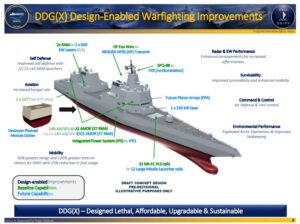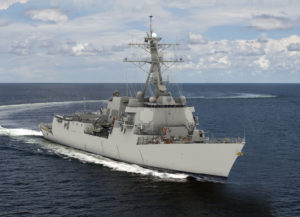The Navy last week awarded contracts to General Dynamics [GD] Bath Iron Works (BIW) and
HII’s [HII] Ingalls Shipbuilding segment for engineering and design analysis for the next generation guided-missile destroyer, DDG(X).
The July 22 Defense Department contract announcement did not disclose the specific contract values because they are “considered source-selection sensitive information and will not be made public at this time.”
These contracts specifically cover the “shipbuilder engineering and design analysis in order to produce design products in support of the Guided Missile Destroyer (DDG(X)) preliminary design and contract design,” the announcement added.

The companies’ work will largely be performed at BIW’s facility in Bath and Brunswick, Me., and Ingalls’ facility in Pascagoula, Miss. and are expected to be finished by July 2023. However, the contracts include options that, if exercised, would extend the work for both contractors through July 2028.
DoD noted the contracts were not competitively procured. BIW and HII currently split construction of the Arleigh Burke-class (DDG-51) destroyers and have been slated to help design and build DDG(X) as well.
DDG(X) is expected to succeed both the Arleigh Burke-class guided-missile destroyers and Ticonderoga-class guided-missile cruisers.
BIW said DDG(X) development will take lessons learned from the DDG-51 as well as the Virginia-class and Columbia-class submarine programs.
The company said those programs “have shown that industry involvement and collaboration from the start of the program is a key enabler to program success.”
“Bath Iron Works is eager to bring our cutting edge engineering and design expertise, now applied to the DDG 51 program, to the next generation of large surface combatants. The opportunity to work alongside HII and our industry partners to meet the Navy’s needs for capability, schedule and cost will result in synergies that build on other extremely successful Navy construction programs,” Bath Iron Works President Chuck Krugh said in a statement.
Likewise, Ingalls Shipbuilding President Kari Wilkinson said HII is “excited to continue on this path with our Navy and industry partners. It provides us a tremendous opportunity to bring best practices and innovation from our experienced engineering team to the design of this important future surface combatant.”
In May, the Navy issued a Request For Information (RFI) seeking industry information on the propulsion system for the DDG(X), specifically electric power and propulsion equipment manufacturers to support design and development of the propulsion components of the DDG(X)’s planned Integrated Power System (Defense Daily, May 25).

In the RFI, the Navy identified BIW as the lead for Electric Propulsion Systems (EPS), which includes propulsion motors, propulsion motor drives, EPS controllers, propulsion transformers, dynamic braking resistors, harmonic filters, and dedicated EPS auxiliaries.
The Navy’s fiscal year 2023 budget request includes $50 million in research and development funds for DDG(X) concept development and $177 million to create a new test facility at Naval Surface Warfare Center Philadelphia Division for use as a land-based testing site for the DDG(X) propulsion system (Defense Daily, April 26).
In January, the Navy exhibited the draft capabilities for DDG(X). It is planned to be a new hull with space to accommodate increased Aegis missile defense capabilities on the DDG-51 Flight III as well as further space, weight, power and cooling allowances for future advanced systems like up to two 600 kW directed energy laser weapons, a more powerful radar, and hypersonic missiles (Defense Daily, Jan. 13).
The DDG(X) initial baseline capabilities are expected to include the new hull, the DDG-51 Flight III combat system, two 21-cell Rolling Airframe Missile launchers to defeat anti-ship missiles, the Flight III SPY-6(V)1 Air and Missile Defense Radar and 32 MK 41 Vertical Launch System cells.